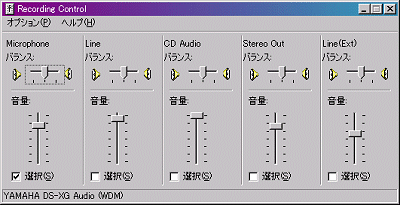| Japanese | English |
1. Sampling rate
The sampling rate, or sampling frequency, determines a time interval to record digital data in 1 second. To analyze the high frequency sound, it is necessary to record many data points in short interval. So, a high sampling rate is required. We can analyze up to half of the sampling rate. If the sampling rate is 44kHz, the frequency up to 22kHz can be analyzed. In RA, the sampling rate can be selected from 8000 to 48000 Hz (in some latest soundcard, up to 96000 Hz is available). We recommend to use as high sampling rate as possible. If the sampling rate is low, the high frequency data will be lost and exact measurement cannot be performed.
2. Sound file (wav file)
It is the binary data representing sound. Additional information such as the sampling rate, resolution (bit), and number of channels (mono or stereo) at the time of recording is also included . Those are necessary information at the time of reproduction. The wav is the most general sound file format in Windows and other OS. Since the wav file is not compressed, it is good for storing the measurement data. However, because the data size becomes too large, it is necessary to take disk capacity into consideration. Generally the data for 45 minutes of 44kHz, 16bit, stereo recording needs about 600MB.
On the other hand, the music data for playing music in real time on the Internet, such as MPEG, is compressed. Since unnecessary data on hearing is excluded, it is not recommended for the measurement.
3. Sound mixer (volume control)
The sound mixer (it is called volume control or a sound driver) of Windows OS (XP, 2000 and 98, ME, 95) controls input and output volume. Software is connected to the WAVE input and output of the mixer. Software receives a signal from the output of the "recording control", and outputs a signal through the "volume control". Two or more processes do not operate at the same time if the function uses the built-in and single-task hardware like AD/DA converter. This means that two different sounds cannot be reproduced simultaneously. The functions without such restrictions can be performed without limitation. For example, the signal generator and the FFT analyzer can work at the same time. You can see the frequency response of the device by the FFT analyzer while generating pink noise by the signal generator.
The sound mixer is the software version of a musical mixer console. An important function of the sound mixer (volume control) is the adjustment of the input and output volume. You have to adjust the optimal signal and noise ratio, and make a sound not distorted.
For beginners, it may be difficult to understand. So, we show the picture of the actual setup of volume control as much as possible in the measurement reports.

The most fatal mistake is raising volume too much. It causes distortion. The simplest method for checking distortion is generating a test signal (sin wave) and seeing the waveform with the oscilloscope. Generally, it is said that the peak level meter is used for the check of distortion. But this is effective only when the amplifier is not distorted at the permission level. If you actually measure, you would understand that there is quite less range which can be used without distortion than the range of a peak level.
Amplifier is further needed when it is used in the state where there is no distortion (with a small volume). Large volume can be obtained without lowering the quality of signal by using a high quality preamplifier instead of a built-in function of PC.
We hope you will make use of the following reports.
Audio measurement report 4 -- Compensation of the
frequency characteristics of a microphone
Audio measurement report 6 -- Measurement of WILSON
AUDIO WATT3 (ROSE)